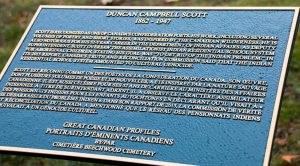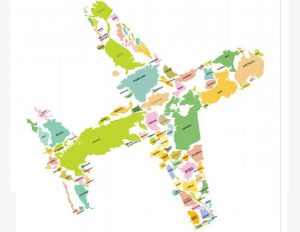Frye writes:
A much more complicated cultural tension [more than two languages] arises from the impact of the sophisticated on the primitive, and vice a versa. The most dramatic example, and one I have given elsewhere, is that of Duncan Campbell Scott, working in the department of Indian Affairs in Ottawa. He writes of a starving squaw baiting a fish-hook with her own flesh, and he writes of the music of Dubussy and the poetry of Henry Vaughan. In English literature we have to go back to Anglo-Saxon times to encounter so incongruous a collision of cultures (Bush Garden 221).
It is interesting, and telling of literary criticism at the time, that while Frye lights on this duality in Scott’s work, or tension between “primitive and civilized” representations; however, the fact that Scott wrote poetry romanticizing the “vanishing Indians” and wrote policies aimed at the destruction of Indigenous culture and Indigenous people – as a distinct people, is never brought to light. In 1924, in his role as the most powerful bureaucrat in the department of Indian Affairs, Scott wrote:
The policy of the Dominion has always been to protect Indians, to guard their identity as a race and at the same time to apply methods, which will destroy that identity and lead eventually to their disappearance as a separate division of the population (In Chater, 23).
For this blog assignment, I would like you to explain why it is that Scott’s highly active role in the purposeful destruction of Indigenous people’s cultures is not relevant for Frye in his observations above? You will find your answers in Frye’s discussion on the problem of ‘historical bias’ (216) and in his theory of the forms of literature as closed systems (234 –5).
Northrop Frye describes literature as a “conscious mythology [which] creates an autonomous world that gives us an imaginative perspective on the actual one” (234). It is this argument that allows Frye to ignore the fact that Duncan Campbell Scott romanticizes Indigenous life while simultaneously implementing policies to destroy that very same culture.
Scott, who was the deputy superintendent of the Department of Indian Affairs from 1913 to 1932, played an active part in the establishment of residential schools and the subsequent removal of Indigenous children from their families, all with the ultimate goal to “to continue until there is not a single Indian in Canada that has not been absorbed into the body politic” (CanLit Guides: “Douglas Campbell Scott”). Meanwhile, he writes of a Native trapper with eyes like “jewels of content / Set in circles of peace” (Campbell 18-19) despite being chased by “whitemen servants of greed” (3). L.P. Weis sums it up nicely when he writes that Scott “consciously divided his life into two parts and wilfully ignored as a poet those morally objectionable aspects of the job he encountered as a bureaucrat” (Weis 27).
While many have tried to reconcile Scott’s words with his actions, or, at very least, have examined the discrepancies, Northrop Frye does not. For Frye, Scott’s actions are irrelevant because they exist outside of the closed system that is literature. Scott writes poetry about the “vanishing Indian”. Frye would say that Scott is giving an imaginary perspective on the conscious mythology of Canada (or the place that the nation of Canada happens to be) and that, although “primitive” in this case (i.e. an Indigenous woman who “took of her own flesh” (Scott 33) to bait a hook), is a closed form of literature. It isn’t necessarily real but rather the shaping of material (in this case, the historical entry into Canada by the colonizer, and the subsequent destruction of the Indigenous people- the “vanishing Indians”). For Frye, this is the beginning and the end, as the literary form of poetry produced by the poet Scott is unrelated (closed) to the historical and real actions of the colonizer Scott who is, in fact, shaping the material that he is then drawing from as a poet. The Indians vanish because they are being vanished by policies that have been penned by Scott, who then moves from the legislative system to the closed system of literature that is uninterested in his genocidal day job.

A controversial plaque “honoring” Duncan Campbell Scott- it recognizes his poetry as well as his role in the residential school system. (See clearer version here).
Historical bias enters into it when we look at how literature views the entry of poets into Canada. The mentality that they are experiencing (really providing an imaginary perspective on the experience and creating a myth from colonizing history) a harsh and unforgiving land and are reporting a romantic interpretation of that land is reinforcing the social beliefs valued by their (Western) culture. The historical bias is in favour of the people who did the colonizing, as they were also the ones colonizing an incipient national literary identity.
In many ways, it makes perfect sense for Scott to romanticize Aboriginal culture in his poetry while at the same time attempting to “get rid of the Indian problem”. As it’s pointed out in The CanLit Guides, “saying racist things in poetic ways makes them seem all the more true” (“Douglas Campbell Scott”). By romanticizing Indigenous culture, Scott is setting it in a mythological framework, and at the same time, removing this culture from the present; if Indigenous people and culture are portrayed as a thing of the past, as a romantic and mythological idea, it suggests that they no longer have a place in the present. Additionally, as The CanLit Guides also points out “the beauty of a poet’s expression is itself an ideological tool” (“Douglas Campbell Scott”).
Works Cited
CanLit Guides. “Reading and Writing in Canada, A Classroom Guide to Nationalism.” Canadian Literature. Web. 24 Feb. 2019.
“Duncan Campbell Scott Plaque”. Whatever He Says. N.p., n.d. Web Image. 26 Feb. 2019.
Frye, Northrop. The Bush Garden: Essays on the Canadian Imagination. 2011. Toronto: Anansi. Print.
Salem, Lisa. “”Her Blood is Mingled with Her Ancient Foes”: The Concepts of Blood, Race and ‘Miscegenation’ in the Poetry and Short Fiction of Duncan Campbell Scott.” Studies in Canadian Literature / Études en littérature canadienne 18.1 (1993): n.pag. Web. 26 Feb. 2019
Scott, Duncan Campbell. “The Forsaken”. Poem Hunter. N.d. Web. 25 Feb. 2019.
Scott, Duncan Campbell. “On the Way to the Mission”. Poetry Nook. N.d. Feb. 25 Feb. 2019.
Weis, L.P. “Scott’s View of History & the Indians”. Canadian Literature 111 (1986): 27–40. Print.


 Lexis Mellish discusses her quest to find a community where she could “feel a part of something”.
Lexis Mellish discusses her quest to find a community where she could “feel a part of something”.